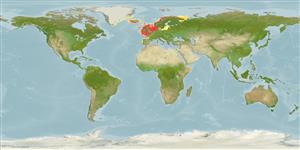ກຸ່ມປາກະດູກແຂງ >
Pleuronectiformes (Flatfishes) >
Pleuronectidae (Righteye flounders) > Pleuronectinae
Etymology: Pleuronectes: Greek, pleura = side, ribe + Greek, nekton = swimmer (Ref. 45335). More on author: Linnaeus.
ສະພາບແວດລ້ອມ / ສະພາບອາກາດ / ລະຍະ
ນິເວດວິທະຍາ
; ສັດທະເລ; ນ້ຳກ່ອຍ ອາໄສຢູ່ໃກ້ໜ້າດິນໃຕ້ພື້ນທ້ອງນ້ຳ; ປາທີ່ມີການເຄື່ອນຍ້າຍໃນສະເພາະມາະຫາສະມຸດ (Ref. 51243); ລະດັບຄວາມເລິກ 0 - 200 m (Ref. 35388), usually 10 - 50 m (Ref. 35388). Temperate; 2°C - 15°C (Ref. 5504), preferred 12°C (Ref. 107945); 72°N - 36°N, 54°W - 45°E
Northern Sea. Reports from the Mediterranean Sea appear to be misidentifications of
P. flesus. It may have been present in some areas of the Mediterranean in the past, as a result of climatic changes related to the ice age, but at present times seem to be absent (Ref. 89040).
Length at first maturity / ຂະໜາດ / ນ້ຳໜັກ / Age
Maturity: Lm 30.8, range 24 - 42 cm
Max length : 100.0 cm SL ຕົວຜູ້/ບໍ່ມີເພດ; (Ref. 4705); common length : 40.0 cm TL ຕົວຜູ້/ບໍ່ມີເພດ; (Ref. 3397); ນ້ຳໜັກສູງສຸດທີ່ເຄຍຈັດພີມມາ: 7.0 kg (Ref. 173); ອາຍຸສູງສຸດທີ່ເຄຍລາຍງານມາ: 50 ປີ (Ref. 173)
ຄີ (ໜາມ)ແຂງຢູ່ຫຼັງປາ (ທັງໝົດ): 0; ຄີຫຼັງຂອງປາ (ຄີອ່ອນ) (ທັງໝົດ): 65-79; ຄີ(ໜາມ) ແຂງຢູ່ຄີກົ້ນປາ
ກຸ່ມປາກະດູກແຂງ
ຄວາມຖີ່ຂອງກຸ່ມຖ່າຍທອດພັນ
ປາທີ່ມີການເຄື່ອນຍ້າຍຈາກທະເລໄປຫານ້ຳຈືດ ແລະນ້ຳຈືດຫາທະເລ
ປາທີ່ມີການເຄື່ອນຍ້າຍຈາກທະເລແລະໄປໄຂ່ຢູ່ນ້ຳຈືດ
ຄີກົ້ນຂອງປາ
ສັດທີ່ມີກະດູກສັນຫັຼງ
ການຖ່າຍທອດທາງກຳມະພັນຈາກພໍ່ແມ່ຫາລູກ 0; ຄີກົ້ນຂອງປາ: 48 - 59. Smooth with small scales. Bony ridge behind the eyes. Upper side brown or greenish brown with irregularly distributed bright red or orange spots. The underside is white. Lateral line straight, slightly curved above pectoral fin. Dorsal fin reaching eye. More than 30 vertebrae.
Adults live on mixed bottoms, the older the deeper the occurrence; small individuals are usually seen on bathing beaches (Ref. 9988). Occurs on mud and sand bottom from a few meters down to about 100 m, at sea, estuaries and rarely entering freshwaters (Ref. 59043). Reported as resident intertidal species with homing behavior (Ref. 32612). Feed mainly on thin-shelled mollusks and polychaetes. Batch spawner (Ref. 51846). The most important flatfish for fisheries in Europe. Utilized fresh and frozen; eaten steamed, fried, boiled, microwaved and baked (Ref. 9988). Active at night in the very shallow water while day time is spent buried in the sand. Stationary for long periods, tagging experiments have shown that their spawning migrations can be long. Changes in the environmental conditions have been disadvantageous. Populations in Kattegat and Danish belts decreased in 1980's and early 1990's due to discharge of nutritive salts. Wadden sea is still an excellent nursery ground (Ref.35388).
Adult spawn when the temperature is around 6 °C (Ref. 4705).
Cooper, J.A. and F. Chapleau, 1998. Monophyly and intrarelationships of the family Pleuronectidae (Pleuronectiformes), with a revised classification. Fish. Bull. 96(4):686-726. (Ref. 30193)
IUCN Red List Status (Ref. 115185)
CITES (Ref. 94142)
Not Evaluated
Threat to humans
Harmless
Human uses
ການປະມົງ: ທີ່ມີການຄ້າສູງ; ການລ້ຽງສັດນ້ຳ: ເປັນສີນຄ້າ; ຊະນິດປາທີ່ຖືກນຳໃຊ້ເຂົ້າໃນການຫາເພື່ອເປັນເກມກິລາ: ແມ່ນ; ຕູ້ປາ: ບ່ອນວາງສະແດງສັນນ້ຳຂອງລັດ
ເຄື່ອງມື
Special reports
Download XML
ແຫຼ່ງອີນເຕີເນັດ
